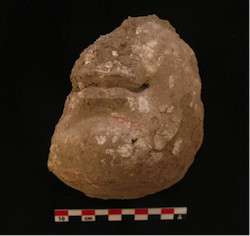
vue d’ensemble du temple de Khardong Choskor, Ladakh ©/MAFIL

fragment en argile peinte, temple de Khardong Choskor, Ladakh ©/MAFIL
by Laurianne Bruneau, Maître de conférences à l’EPHE, Directrice de la Mission Archéologique Franco-Indienne au Ladakh.
The introduction of Buddhism in Ladakh (Western Himalaya, India): new archaeological data.
Our knowledge of the implantation of Buddhism in Ladakh is fragmentary and relies, to a large extent, on late written sources. Although some material data exist, they have been the subject of little research and this is not exhaustive. The work carried out by the Franco-Indian Archaeological Mission in Ladakh (MAFIL) allows a new understanding of ancient Buddhism (that is, prior to the 12th century) for the region. Thanks to radiocarbon dating and the analysis of the material (architectural plan, ceramics, rock inscriptions) of the Tirisa site, we are now in a position to affirm that Buddhism was established in Ladakh, or at least in one of its valleys (the Nubra), from the middle of the first millennium. Regarding the Second Diffusion of the doctrine linked to the Western Tibetan kingdoms in the 10th-11th centuries and its implications in Ladakh, Nyarma is undoubtedly the best-known site. However, many other sites with ruined temples exist. Excavations were carried out on a mud-brick temple in Khardong Choskor, north of Leh oasis. The architectural elements uncovered, as well as the fragments of murals, sculptures and votive objects in clay, make it possible to better understand the place of Ladakh in the expansion of Buddhism in the Western Himalayas.

